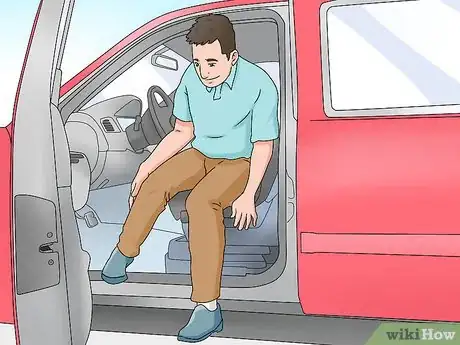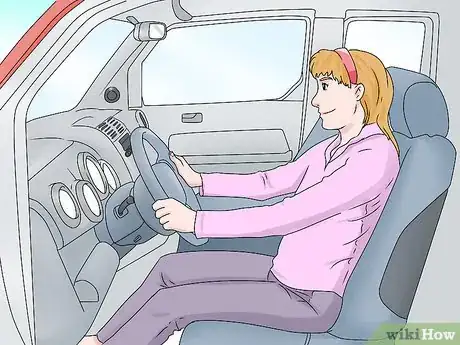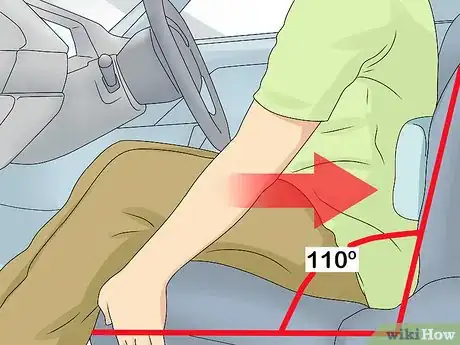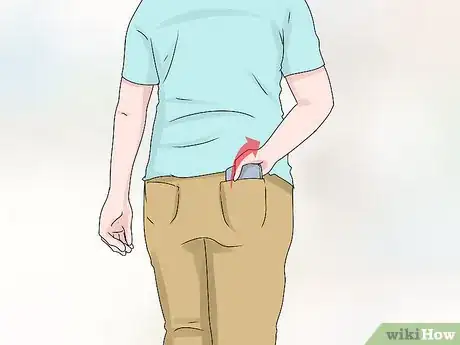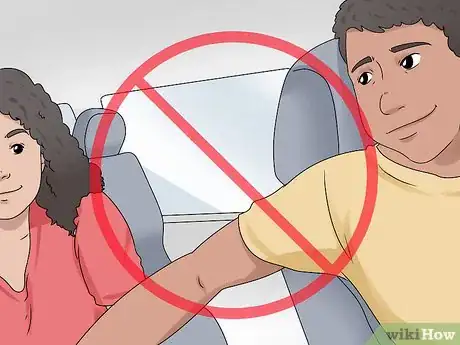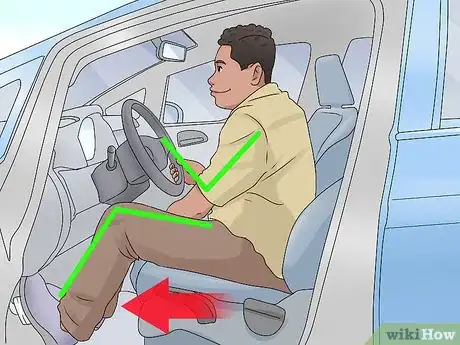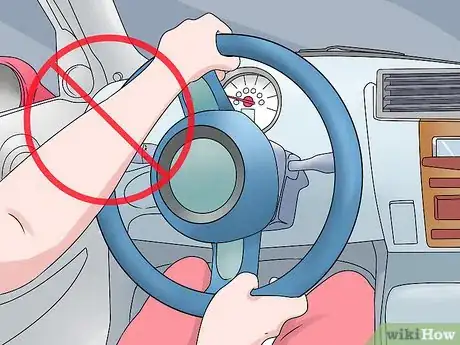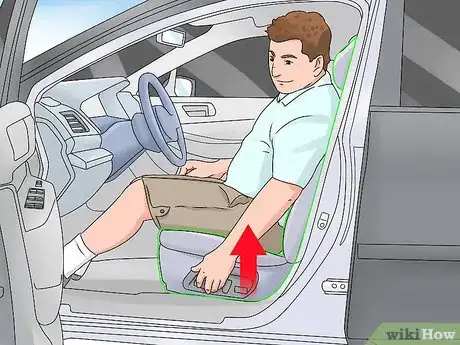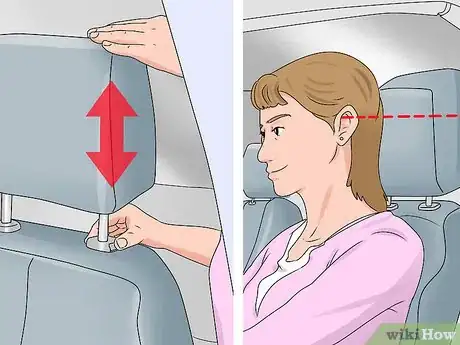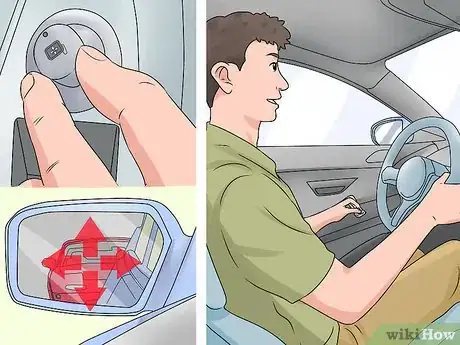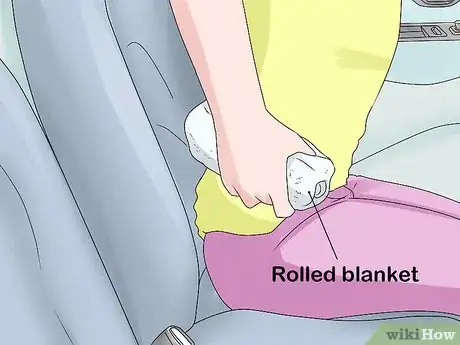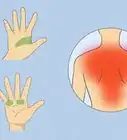This article was medically reviewed by Stuart Rammell, DO. Dr. Stuart Rammell is a board certified Interventional Pain Specialist. He specializes in helping patients reduce pain and improve bodily function through spine and peripheral injections, radiofrequency ablation, and spinal cord stimulation. Dr. Rammell holds a BS in Exercise Science from Brigham Young University and a DO from Midwestern University. He completed his fellowship and residency in interventional pain medicine and anesthesiology at Loma Linda University.
There are 7 references cited in this article, which can be found at the bottom of the page.
This article has been viewed 319,010 times.
Sitting in a car for an extended period of time can take a toll on your back, but there are steps you can take to prevent stiff, sore muscles and joints. Sit in a neutral, ergonomic position, and try not to slouch. Tuck your bottom all the way into the seat and keep your shoulders against the backrest. Adjust your seat so your knees and elbows are slightly bent, and set the headrest so it’s level with the top of your head. Try using a rolled towel or small blanket for extra lumbar support, or ask your doctor to recommend a specially designed ergonomic cushion.
Steps
Sitting Mindfully within a Car
-
1Enter the car hips first. Try not to just jump in and out of your car. Bring your hips into the car first, sit on the seat, then rotate your knees to bring them in front of you. When you exit, rotate your knees out of the car, then step up and lift yourself out of the seat.
- If you have an SUV, truck, or other automobile with a high step, see if you can add an extra step or running board to make it easier to get in and out of your seat.
- Avoid rapid twisting motions as you enter your car.[1]
-
2Sit up straight while driving your car. Sit in a neutral position with your chest out, shoulders back, and lumbar spine, or lower back, slightly curved toward the steering column. You should have enough headroom to hold your head up high and straight without bumping it when you pass over a pothole.[2] [3]
- Slumping in a non-neutral position puts strain on your back over extended periods of time.
Advertisement -
3Tuck your bottom into the seat. Push your bottom as far back into the seat as possible. Rest your shoulders on the backrest so your body is tilted backward at an angle of about 110 degrees. Try to make sure the seat supports as much of your thighs as possible.[4]
-
4Remove things from your back pockets. Take your wallet, keys, and other items out of your back pocket before sitting in the car. A packed wallet and other pocket-fillers can throw your pelvis out of alignment, which could cause or aggravate back pain.
-
5Avoid reaching across the car. While driving or riding in a car, try to stay in a neutral, ergonomic seated position. Do your best to avoid reaching for the passenger side or back seat to look for something or soothe a fussy youngster.
- Reaching or overextending while seated in a car can hurt your back. If possible, pull over when you need to find some paperwork or grab something for your little one in the back seat.
Adjusting the Seat
-
1Bring your seat forward so your elbow and knees are slightly bent. You should be close enough to the steering column that you can steer with your elbows slightly bent and access the pedals with slightly bent knees. Grabbing the wheel with fully extended elbows can cause back and arm pain.[5]
- The steering wheel should be 10 to 12 inches (25 to 30 cm) away from the driver’s chest.
- If your seat has adjustable lumbar support set it to a comfortable position. Your lower back should be slightly curved toward the steering column while making complete contact with the seat. Your feet should read the pedals without shifting your hips. Bring your seat base forward if you feel your hips shifting while driving.
- Make sure that you're sitting as straight as possible without hunching forward.[6]
-
2Avoid gripping the wheel too tightly. Too tight of a grip can cause excessive tension which can lead to neck, shoulder, and upper back pain. Try relaxing the shoulders, which will likely move them down and help you maintained a relaxed posture.[7]
-
3Set your seat as high as possible. The seat should be set as high as possible so that your legs are relaxed and slightly bent. You should be able to see out of the car with ease and without obstruction.[8]
- Make sure you still have enough headroom that you won’t bump your head.
-
4Position the headrest so it’s in line with the top of your head. The top of the headrest should be level with the top of your head. While sitting the car, your head should lie comfortably against the headrest or be held within two to three inches of it.
- A headrest must be positioned high enough to protect from whiplash injuries in the event of an accident.
-
5Set your mirrors while you’re in an ergonomic position. The best time to adjust mirrors and other instruments is when you’ve put yourself in a comfortable, ergonomic driving position. Set your mirrors so that they’re positioned for a non-slumping vantage point.
- If, while driving, your mirrors seem like they need to be readjusted, you’ll know that you’re starting to slouch and need to sit up straight.
Using Pillows and Supports
-
1Roll a small blanket or towel to create a lumbar support. If your car doesn’t have a built-in adjustable lumbar support, you can make your own. Roll up a towel, blanket, or tee shirt and place it at the base of the seat’s back rest. This should support your lower back’s natural curves and help keep you from slouching.
-
2Get a seat cushion if your seat is too deep. Sitting on a pillow or cushion might be your best option if your seat is on the highest adjustment but you still have trouble reaching the wheel or seeing your mirrors. If you’re tall and your knees bend more than slightly above your hips when you sit in the car, a seat cushion could also help you maintain a more ergonomic position.
- The ideal sitting position is to have about 2-3 fingers worth of space between the back of your knee and the front of the seat.
- Your knees and hips should be on approximately the same plane, with your slightly bent knees resting at a height just higher than your hips. You should make an adjustment if, when you sit in the car, your knees are bent at a 90 degree angle and their tops are at a much greater height than your hips.
-
3Ask your doctor about supports and long-term solutions. If you haven’t had much luck with rolling towels or sitting on pillows, you might want to invest in a support or cushion specially designed to prevent and relieve back pain due to driving. Ask your doctor to recommend a product that will address your specific back issues.
- If you consistently experience back pain, ask if they can refer you to a spinal specialist or help you come up with a long-term management plan.
References
- ↑ Stuart Rammell, DO. Board Certified Interventional Pain Specialist. Expert Interview. 1 September 2021.
- ↑ https://www.ccohs.ca/oshanswers/ergonomics/driving.html
- ↑ Stuart Rammell, DO. Board Certified Interventional Pain Specialist. Expert Interview. 1 September 2021.
- ↑ http://www.sportsinjuryclinic.net/sport-injuries/low-back-pain/back-pain-and-driving
- ↑ https://www.ccohs.ca/oshanswers/ergonomics/driving.html
- ↑ Stuart Rammell, DO. Board Certified Interventional Pain Specialist. Expert Interview. 1 September 2021.
- ↑ https://www.yogajournal.com/teach/alignment-cues-decoded-draw-shoulders-down
- ↑ https://www.driving.co.uk/car-clinic/how-can-i-make-sure-i-have-found-the-perfect-driving-position/
- ↑ https://www.spine-health.com/blog/7-tips-alleviate-back-pain-your-road-trips
About This Article
If you get back pain from sitting in the car for long periods of time, you can make yourself more comfortable by maintaining good posture and taking regular breaks. Although it can be tempting to slouch a little, try to keep your back straight and your shoulders back. Lift your seat as high as you can while keeping your legs relaxed and slightly bent. If your seat’s still too low at its highest or it’s uncomfortable, sit on a cushion. You can also place a rolled-up blanket, towel, or t-shirt behind your lower back if your car seat doesn’t have lower back support. Don’t forget to take regular breaks and stretch your legs when you’re driving long distances. You should also stretch before you get in the car and during breaks to improve your blood flow. For more Driving tips from our co-author, including how to position your headrest, read on!
